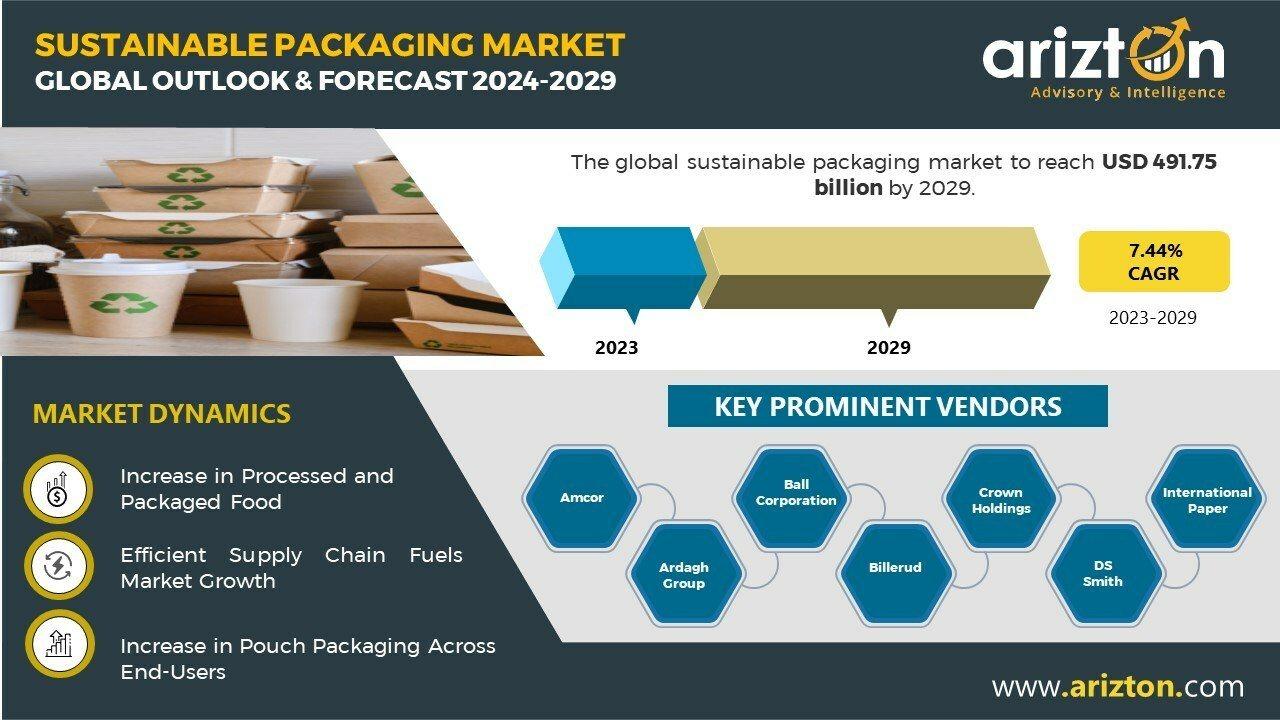According to Arizton’s latest research report, the global sustainable packaging market is growing at a CAGR of 7.44% from 2023 to 2029.
Recycled paper and plastic packaging make up most of the sustainable packaging market, and they are expected to maintain their dominant position due to consumer familiarity and the well-established recycling infrastructure. However, the landscape is evolving, with the degradable and compostable containers crafted from materials such as plastic, wood, and non-wood fibers gaining significant traction. Quick-service restaurants (QSRs) are at the forefront of adopting these new packaging trends, while Consumer Packaged Goods (CPGs), although somewhat slower in adoption, have the potential for substantial long-term growth with these innovative packaging solutions.
Leading role for Europe
In 2023, Europe led the global sustainable packaging market share, driven by rising consumer awareness and strict government regulations against single-use plastics. European consumers increasingly favor sustainable products and packaging, with a significant portion altering their purchasing decisions due to packaging concerns. Moreover, most European consumers are willing to pay more for environmentally friendly packaging, further boosting demand. Stringent government regulations to reduce single-use plastics also fuel European green packaging demand.
Following closely, North America is experiencing growth in sustainable packaging, propelled by an expanding eco-conscious consumer base and corporate sustainability initiatives. The United States and Canada have made notable strides in promoting eco-friendly packaging. As consumer awareness of the environmental impact of their purchases rises, the sustainable packaging market in North America is expected to continue its upward trajectory.
In the APAC, rapid growth in the sustainable packaging market is driven by factors such as a growing middle class, increasing environmental concerns, and a shift towards sustainable practices in emerging economies. Asia-Pacific is forecasted to experience the highest compound annual growth rate (CAGR) during the projected period.
Key developments
- In February 2023, Sealed Air Corporation acquired Liquibox, a leading provider of sustainable bag-in-box packaging solutions for various industries.
- In 2022, Smurfit Kappa set up the Design2Market Factory, specifically created to meet customer needs in product development and launch.
- In 2023, Crown Holdings acquired Helvetia Packaging in Saarlouis, Germany.
E-commerce and online retail have significantly increased demand for sustainable packaging solutions. With the increased volume of shipped products, there is a focus on minimising packaging waste, opting for recycled materials, and utilising packaging designs that reduce excess materials. Brands increasingly invest in sustainable packaging to meet customer expectations and demonstrate their commitment to environmental responsibility. Further, in the electronics industry, there is a push for sustainable packaging that ensures the protection of delicate electronic components while reducing waste. Sustainable materials, such as cardboard and molded pulp, are being used for packaging, and electronic companies are investing in designing packaging solutions that are easily recyclable or reusable, thereby aligning with the broader sustainability goals of the industry.
Moreover, the burgeoning e-commerce market in China is poised to significantly impact the profitability margins for a broader spectrum of industry players, a domain currently dominated by larger, established entities. Active across multiple end-user sectors, these leading players enjoy healthy profit margins. A notable trend is the push towards reducing excess packaging to minimise waste cut down on shipping costs, and bolster overall operational efficiency. Given the centrality of distribution channels in e-commerce, safety and efficiency in transportation emerge as critical concerns, with a spotlight on product quality and safety. Sustainable, flexible packaging emerges as a pivotal solution, offering multi-layered films that provide superior protection against food spoilage from air, moisture, and sunlight. Consequently, sustainable packaging solutions can extend the shelf life of food by up to five times compared to traditional packaging methods. With the e-commerce landscape expanding rapidly, the imperative for environmental responsibility is gaining traction. Brands are rising to the occasion, prioritising sustainability, and adopting innovative strategies to address these challenges head-on.
Paper & paperboard packaging holds strong market share, plastic material gains momentum in growth
The sustainable packaging market has seen a significant rise in the utilisation of paper and paperboard due to their eco-friendly properties. Paperboard has witnessed evolution and diversification, finding applications in various forms such as medical packaging, beverage cartons, promotional displays, and produce containers. These materials are favoured for their renewability, recyclability, and low environmental impact, aligning with sustainable packaging goals. In China, while paper and cardboard production saw a slight increase, there was a decrease in paper product production and consumption in 2022. However, production and consumption have shown stable growth over the past decade, albeit with fluctuations. These dynamics underscore the importance of sustainable and efficient utilisation of paper resources in packaging, driving innovation to meet evolving consumer and environmental demands.
Plastic’s role in the sustainable packaging market is complex, offering benefits like versatility and cost-effectiveness but also raising environmental concerns. Bioplastics, made from renewable resources like cornstarch or sugarcane, present a sustainable alternative. With a global production capacity of 2.2 million tons in 2022, bioplastics are increasingly used in packaging, especially for organic and high-end products. Anticipated growth to 6.3 million tons by 2027, focusing on innovative solutions, underscores their importance. As seen in the European Green Deal, government support is crucial for promoting bioplastic adoption. Rigid bioplastics, such as PLA, bio-PE, and bio-PET, are popular in cosmetics and beverage packaging due to their high bio-based content and recyclability benefits. Flexible packaging solutions using bioplastics cater to the demand for biodegradability in perishable food items, extending shelf life and reducing environmental impact. This shift towards bioplastics reflects a broader effort to transition towards a bio-based economy, emphasizing sustainability and resource efficiency.
https://www.arizton.com/market-reports/sustainable-packaging-market

